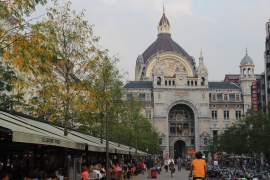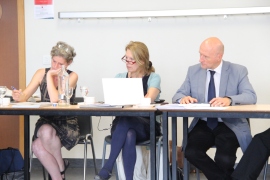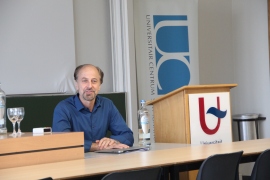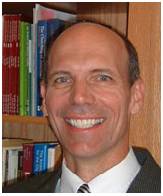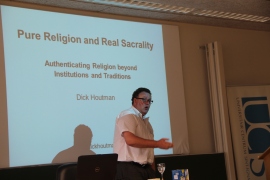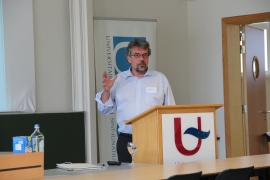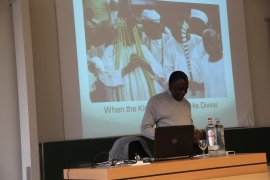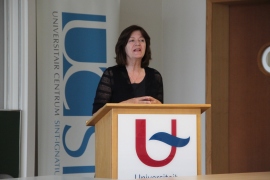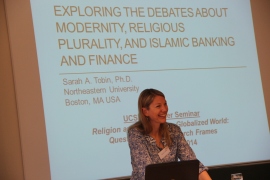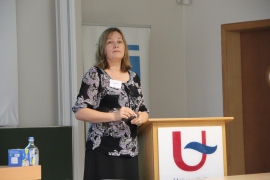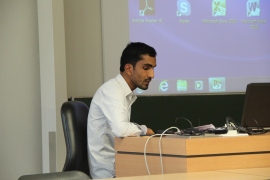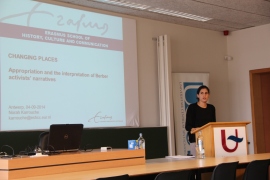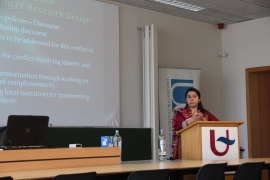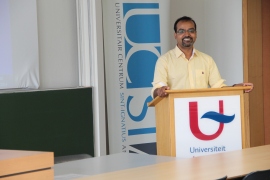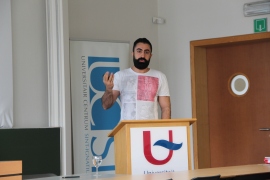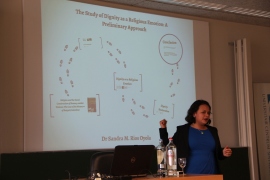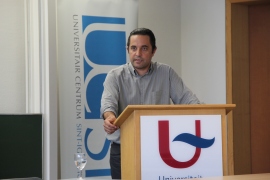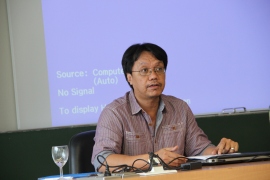Archive for Politics in Pakistan
International Aid, Civil Society and Politics of Development
Development Aid Confronts Politics: The Almost Revolution by Thomas Carothers and Diane de Gramont. Washington, DC: Carnegie Endowment for International Peace, 2013; How to Manage an Aid Exit Strategy: The Future of Development Aid by Derek Fee. London: Zed Books, 2012.
_______________
Debates on international development aid are not new; some have supported aid, some have opposed it. In his bestselling 2005 book, The End of Poverty, Jeffrey Sachs urged rich nations to increase foreign aid to poor countries not just to end their ‘poverty trap’, but also to kick-start development. In contrast, William Easterly and Dambisa Moyo have strongly argued against aid and noted that it does more bad than good – ‘it prevents people from searching for their own solutions, while corrupting and undermining local institutions and creating a self-perpetuating lobby of aid agencies’ (Quoted in A. Banerjee and E. Duflo, Poor Economics, Public Affairs, 2011, pp. 3–4). The question here, however, is not about whether we should have aid or not; it is rather about what kind of aid we should have, how we should implement it and how aid can be made more effective in achieving its objectives. In Development Aid Confronts Politics, Thomas Carothers and Diane de Gramont heavily criticise the governance-oriented, technocratic and depoliticised approach to aid practised to date and insist instead on bringing politics to the centre of aid distribution and management.
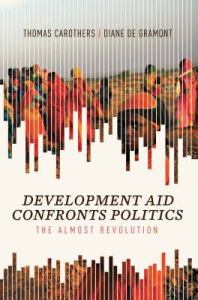
Exploring the history of politics in development aid, Carothers and de Gramont note that although aid was intimately related to Cold War politics, aid agencies in the formative years shied away from adopting explicitly political goals for they believed that socio-economic assistance would create domestic conditions conducive for political development and the spread of democracy. It was, however, observed that economic development, instead of bringing democratisation, ‘heightened political conflict, violence, and repression’, leading to authoritarianism (p. 29). The aid community did not have much choice: ‘[D]evelopmentalists on the ground stayed clear of “playing politics” in order to gain credibility with host governments and aid receiving societies’ (p. 50). Such apolitical and technocratic approaches to developmental planning, which often resulted in over-centralised power structures, were heavily criticised. As a result, aid organisations began to rethink their beliefs about the role of politics in the development process. Carothers and de Gramont seem happy that, today, most of the aid organisations have adopted and are actively pursuing political goals either directly with governments or indirectly with political parties and civil society organisations. Emphasising the indispensability of politics in understanding and crafting social change, the authors conclude that ‘aid programs should grow out of the local context and focus on feasible rather than best-practice solutions, that technical assistance should feed into indigenous processes of change, that projects should think about their place within the broader political systems, and that aid providers must focus closely on understanding how political and institutional change occurs’ (pp. 192–3).
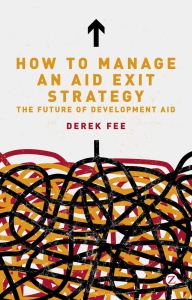
Although Derek Fee would agree with Carothers and de Gramont on how to make aid more effective, in How to Manage an Aid Exit Strategy he asks a different question: ‘why development aid is alive and kicking despite calls from both Africa (the continent demanding the highest level of aid) and donor country leaders to bring the business to a logical conclusion’ (p. xi). He further asks ‘why an activity that was supposed to be time-bound has expanded way beyond its initial remit’ (p. xi). Integrating academic knowledge and a practitioner’s experience, Fee addresses these questions quite innovatively. He argues that it is not just aid dependency that has had many negative effects, but that the aid business itself is now in crisis and cannot continue indefinitely. It is thus necessary for both donors and recipients to rethink the development aid model and devise clear exit strategies. Fee suggests several initiatives (e.g. domestic resource mobilisation, trade liberalisation, regional integration, microfinance, remittances and non-governmental organisations, and philanthropic institutions), which he believes could act as policy options for replacing development aid and making countries sustainable. He concludes that although an aid exit strategy is important, it ‘should not punish people’ who have suffered poverty and deprivation. It ‘must be applied with compassion or it will be ineffective. It must [also] be time-bound but the time given to each country should be related to their base line of aid dependency’ (p. 232).
While Carothers and de Gramont have successfully brought politics to the heart of the aid business, Fee has convincingly argued for a time-bound and compassionate aid exit strategy. Both books are filled with rich historical analysis and empirical examples and the authors exhibit immense awareness of and sensitivity to the political context. Though some may criticise these books for lacking theoretical rigour, they nonetheless represent excellent contributions to understanding the modern aid industry and the way it has evolved over time. Both books are lucidly written and well-argued and should be recommended not just to students of sociology and international relations, but also to aid practitioners, civil society activists and public policy officials.
_______________
@ Reviewed by Sarbeswar Sahoo, Political Studies Review, Vol.12, No.3, Sept., 2014, pp.418-419.
Patronage as Politics in South Asia
Patronage as Politics in South Asia by Anastasia Piliavsky (ed.). Cambridge: Cambridge University Press, 2014. 469pp., £75.00 (h/b), ISBN 9781107056084
Anastasia Piliavsky’s Patronage as Politics in South Asia, which grew out of a colloquium held in 2011 at Kings College, Cambridge, investigates the nature and importance of patronage in the socio-historical context of South Asia. Piliavsky asks: is patronage necessarily a bad thing? What are the ways in which patronage is understood and exercised in South Asia? Most importantly, what is the relationship between patronage and democracy? Does patronage undermine or complement the functioning of democratic political order? Drawing on theoretical literature from political science and anthropology and extensive ethnographic fieldwork in South Asia, the essays in this volume argue that patronage is not necessarily always a bad thing as it is often characterised in the Western political imagination; in the South Asian context, it is an inherently plural concept, which has a contingent relationship with democracy.

Piliavsky’s comprehensive introduction provides an extensive review of the literature on patronage politics around the world and sets the tone for the book. The sixteen essays by eminent scholars are organised under three sections: the idea of patronage, democracy as patronage, and prospects and perils of patronage. The first section looks at the nature of the patron-client relationship in South Asia. The essays in this section demonstrate how wealthy patrons use their wealth to establish religious and educational institutions to influence the lives of their clients and structure their sense of history and belonging. In the second section, the authors examine how patronage influences electoral decisions and vote bank politics. They show that patronage is not merely an instrument of exchange; it is rather a system of relationship in which patrons are expected to show their munificence through gifts, feasts, developmental provisions and bureaucratic help, and the clients reciprocate with their loyalty.
The final section discusses the perils of patronage and shows how clients (i.e. voters, migrants and subaltern masses) are trapped in a cycle of chronic bondage due to criminalised political ecologies and ineffective legislation. The essays conclude that in South Asia „“patronage” does not apply to a narrowly defined set of political relations; it encompasses the fundamental principle of social life far beyond the political‟ (p.29). „Political patronage is an expression of the broad moral sense that shapes the ways in which people relate across social levels and contexts. The essence of this moral formulation is the idea that in South Asia differences of rank do not prevent relations, but promote intimacy between parties in distinct and complementary roles‟ (pp.29-30).
Broadly, the book provides an excellent comparative ethnographic account of patronage politics in South Asia. The essays are empirically sound and theoretically sophisticated; they are also written in a lucid and coherent manner. Taken together, the essays will be immensely useful to students and scholars of anthropology, political science and South Asian Studies.
SARBESWAR SAHOO
Indian Institute of Technology Delhi
__________________________
© Forthcoming in Political Studies Review, Vol.14, No.3, August 2016.
UCSIA Summer Seminar (2014): Religion and Culture in a Globalized World
For almost a decade, the Universitair Centrum Sint Ignatius Antwerpen (UCSIA) has been organising a summer school on Religion, Culture and Society. It invites more than twenty young researchers to come to Antwerp (Belgium) and participate in a week long intense intellectual discussion on the role of religion in modern society.
While the major theme is related to Religion, each year’s summer school deals with a particular topic such as, Multiculturalism (2008), Religion and Politics (2009), Religion and International Relations (2011), Secularism(s) and Religion in Society (2012), and Religion, Reform and the Challenge of Plurality (2013).
This year (2014), the UCSIA organisers decided to bring back some of the alumni of the summer school to discuss the theme: Religion and Culture in a Globalized World: Questioning our Research Frames. It was held during 3-5 September 2014. The objective was to discuss ‘how to research religions in a global world taking into account the various disciplinary perspectives and cultural-religious contexts: What new research questions arise in a space that allows for these diversities?’
Some of the important questions were: How do plural societies affect religions towards changing their own attitudes with regard to one another and revising their role in society? How do religious convictions and perspectives on citizenship relate to one another? Can one ‘belong’ to various cultures and religions?
The UCSIA had invited 6 distinguished professors of religion and culture from various universities of the world to engage with the above mentioned theme.
Robert Hefner, Professor of Anthropology and Director of the Institute on Culture, Religion and World Affairs at Boston University, spoke about “Deep Pluralism: Secularism, Revival, and the Challenge of Pluralist Co-Existence”. In this talk, Hefner discussed ‘the challenge of pluralist co-existence in a post-secularist age’. For him, the secularization hypothesis, which assumed that religion will decline or become privatized as societies modernize, has proven wrong. Today religion is, except Western Europe, very vibrant and resurgent in the global south.
Roger Finke, Professor of Sociology and Religious Studies, Department of Sociology and Religious Studies and Director of the Association of Religion Data Archives, Pennsylvania State University, gave a talk on “Going Global: Testing Theories with International Data”. Professor Finke talked about the usefulness of quantitative methods and large-scale data in research on religion. He particularly discussed the advantages of Association of Religion Data Archives and how it can be used to complement qualitative and anthropological research on religion in globalizing world.
Dick Houtman, Professor of Sociology of Culture and Religion at the University of Leuven, and Faculty Fellow at the Centre for Cultural Sociology, Yale University, talked about “Pure Religion and Real Sacrality: Authenticating Religion beyond Institutions and Traditions”. In this lecture Houtman addressed processes of religious change in Western Europe since the mid-twentieth century. In so doing, he discussed the decline of religion and the privatization of religion as argued by Peter Berger and Thomas Luckman. The question for him was how culture has changed and how the de-traditionalization and anti-institutionalism has given rise to holism and self-spirituality. In addition, Houtman also spoke about the New Age Religious Movements in Europe that argue that “thou shall not accept religious authority”. For future research, Houtman pointed out two major themes: (1) studying religiousness of new age – what roles do shared beliefs, socialization processes, and social control play in the spiritual milieu, and (2) studying the spirituality of the Christian religion.
Thijl Sunier, Professor Cultural Anthropology and Chair ‘Islam in European societies’ at the VU University Amsterdam, spoke about “Making Islam Work: religious ethics and every-day experiences”. Following Robert Putnam, Sunier talked about the various stakeholders of making Islam work in the Western context. He spoke about various agents such as the Muslims, the State and the native Europeans and their role in creating a more tolerant society. He introduced two basic concepts (1) everyday religion, and (2) religious authority in understanding the religious landscape of Europe.
Jacob Olupona, Professor of African Religious Traditions, and Professor of African and African American Studies in the Faculty of Arts and Sciences, Harvard Divinity School, addressed the audience on “the Changing Role of Religion in Contemporary Nigeria”. In this talk, Professor Olupona talked about the Yoruba understanding of sacred authority. For him, traditional religions, symbolizing the “pure” African spirit, were the ideal building blocks for the new identity in Nigeria. But the spread of Pentecostal Christianity among the Yoruba has transformed the religious landscape. As a result, Nigeria is witnessing a shift from pluralism of the post-independence period to plurality dominated by Pentecostal-Charismatic discourse.
The final lecture was given by Juliane Schober, Professor of Anthropology of Religion and Director of the Centre for Asian Research and Professor of Religious Studies at Arizona State University. The title of her lecture was “Buddhist-Muslim Tensions and the Genealogy of ‘Political Monks’ in Myanmar”. In this lecture, Professor Schober traced the genealogies of monastic engagement with politics in Myanmar. She emphasised that sources of reality lies in the social context. Contrary to the population imagination associated with Buddhism as a religion of peace and harmony, professor Schober showed how Buddhist monks in Myanmar have turned violent and even often justified anti-Muslim riots. For her, secularism is a weak tradition in Myanmar because of the long-established military rule and lack of a proper Constitution. In this talk she looked at religion as historical discourse to invoke universal claims and moral practices and locate the voices of Burmese Buddhist monks within social moments to show how religious identities emerge from – or are submerged by – larger political and ethnic convergences.
Besides these six wonderful and theoretically informative lectures, the summer seminar also brought together 11 papers by the alumni.
Sarah A. Tobin, Carnegie Visiting Scholar and Assistant Director of the Boston Consortium for Arab Region Studies North-eastern University, Boston, spoke about the Debates about Modernity, Religious Plurality and Islamic Banking and Finance. The central question was: Is Islamic Banking and Finance Modern? Sarah provided a historico-anthropological account of the Islamic banking and finance and compared it in countries like Pakistan, Malaysia, and Jordan. Islamic Banking is, Sarah noted, the fastest growing industries in the world today.
Inna Naletova, GIZ Deutsche Gesellschaft für Internationale Zusammenarbeit GmbH, Bonn-Eschborn, GIZ-office in Duschanbe, talked about Multiple Modernities in Tajikistan. For her, the central question was: Is a Religious Modernity Desirable in Tajikistan? In so doing, she narrated the story of the “bibiotoun” who are the female teacher of Islam. Inna also talked about the deep pluralities in the market place and the factors that stand as challenges to pluralism. For Inna, the central idea behind Tajiki modernity is the recognition of plurality.
Renny Thomas, PhD Candidate in Sociology and Social Anthropology, Centre for the Study of Social Systems, School of Social Sciences, Jawaharlal Nehru University, discussed ‘Being Religious Being Scientific’: Science, Religion, and Atheism in Contemporary India. For Renny, the boundaries between religion and culture are blurred. It is in this context Renny brings out the idea that how the Indian scientists celebrate certain religious functions and justify their celebration by portraying them as cultural. Renny also talked about the act of scientific rationalism and the act of culturalization. This shows that Indian nationalism has hegemonically been Hindu.
Norah Karrouche, Visiting Researcher, Centre Jacques Berque pour les Etudes en Sciences Humaines et Sociales au Maroc, talked about Changing Places: Appropriation and the Interpretation of Berber Activists’ Narratives. Norah beautifully presented the dilemmas of doing research and also about many of the moral and ethical questions that the researcher faces in the field. While discussing the Berber activism, Norah touched upon issues like recognition of rights, their culture, history and identity and also the issues of religious and democratic values.
Saira Bano Orakzai, Visiting Fellow, School of Advanced Study, University of London presented on Religion and Historical Narratives: Islam-West Historical Encounters and Its Impact in the Post 9/11 period. Saira discussed the construction of history and narrative in the FATA autnomous region of Pakistan by addressing issues of British colonialism, grievances, victimhood and developmental discrimination. For her, it was important to understand the relationship between the meta-narratives and the local grienvances in order to understand the encounters between Islam and the West. In a sense she advocated for a discourse of complementarity. Saira also emphasised that it is important to reframe conflict by including not just the identity narratives but also the local discourse in the meta-narrative.
Fakhereh Khatibi Jafari, Teaching Assistant, Faculty of Education Studies, University Putra Malaysia, discussed Religious Socialization in Iranian Islamic Girls’ School. She took the experiences of the children who have finished their school years and discussed their ideas and engagement with Islam and everyday religiosity in Iran. For Fakhereh, many of the Iranian parents prefer to send their children to private schools with the belief that such schools are effective in socializing their students toward the Islamic-Shiite religious worldview. Fakhereh’s study provided lights on how attending private Islamic schools in Iran impacts on the construction of students’ religious beliefs and attitudes.
Sarbeswar Sahoo, Assistant Professor of Sociology, Indian Institute of Technology, Delhi, India, gave a talk on Spreading like Fire: Growth of Pentecostal Christianity among the Tribals of North India. According to Sahoo, the secularization hypothesis, which assumed that religion will decline or become privatised with the spread of modernity and techno-scientific rationality, has proven ineffective in the Asian context. There seems to be a religious revival in Asia, particularly in the Indian context and the Pentecostal Christianity is increasingly spreading amongst the tribals or indigenous peoples of north India. Compared to the so-called “mainline” churches, the Pentecostals have come to be more effective in transforming the religious experience of the people at the margins and provided them with better alternatives.
Osman Sahin, PhD candidate, Department of Political Science, Sabanci University, Turkey (co-author of the paper: Dr. Sema Akboga, Department of History, Koc University), gave a talk on The Rule of Law and Democracy in Turkey: The Impact of Identity on Perception. Osman tried to discuss how the Western understanding of democracy is quite abstract and theoretical. Through a survey of what democracy means to people in Turkey Osman tried to discover some concrete dimensions and everyday manifestations of democracy. For him, what is necessary is not an elite driven, theoretical model of democracy but a more people centred approach which will be able to capture the everyday problems that the citizens face in a democratic set up and how they engage with those problems through the rule of law.
Sandra M. Rios Oyola, PhD in Sociology, Department of Sociology, Aberdeen University, gave a talk on The Study of Dignity as a Religious Emotion. For Sandra, dignity can be understood as people’s sense of self-worth as human beings and contrary to the feeling of humiliation. Humiliation can be considered as an attack against the person’s dignity. In the context where the dignity is violated, the important question is how to restore the dignity and self-worth of the person. What are the mechanisms through which human dignity can be restored? Sandra explains this through emotional sources such as trust, hope, and empathy, which she believes, have their root in religion.
Mentor Mustafa, Lecturer at the Summer School & at the Metropolitan College, Boston University & PhD candidate, Department of Anthropology, Boston University, gave a talk on From the Ashes of Atheism: The Reconstitution of Religious Life in Post-socialist Albania. In this talk, Mentor discussed the reconstitution of religious experience of the Bektashi community during the post-socialist period. For him, there is clear decline of religious experience and he goes on to argue that the legacy of communism in Albania shattered the late nineteenth century pattern of religious authority and popular religiosity. He also discussed the challenges to the rebuilding of the religious community in Albania.
Hector Guazon, Assistant Curator, Saint Louis University- Baguio City Senior Lecturer, University of the Philippines-Diliman discussed the Shifting Socio-moral World of the Filipino Catholic in Brussels, Belgium. The central question was: how socially differentiated Filipino migrants intimately explore Roman Catholicism’s meanings and values as they create the Filipino Chaplaincy within their unstable diasporic context? Hector argued that among the Roman Catholic principles and concomitant resources that Filipino Catholics appropriate, along with their fellow Filipinos in Brussels, “standing for the marginalized” becomes a potent force for church authorities as well as Filipino religious and civic leader’s claim to cooperation, leadership, and dejection.
________________
Religion, Politics and Liberal Democracy
Faith in Politics: Religion and Liberal Democracy by Bryan T. McGraw. Cambridge: Cambridge University Press, 2010. £14.99, 328pp., ISBN 978 0 521 13042 4
The Political Origins of Religious Liberty by Anthony Gill. Cambridge: Cambridge University Press, 2008. £19.99, 270pp, ISBN 978 0 521 61273 9
Religion has historically been at the centre of people’s understanding of their lives as well as the world and it has provided divine legitimacy to political authority. The occurrence of religious wars in Europe in the sixteenth and seventeenth centuries, however, resulted
in the decline of the public and political role of religion in modern society. Modernisation theorists also predicted that, with the advancement of science and technology, religion’s significance in society will decrease, leading to thorough secularisation. The secularization thesis argued for the separation of the church and the state and declared religion as incompatible with the idea of modernity and democracy. However, the recent resurgence of religion in the public and political spheres and the increasing religious fundamentalism around the world has generated many questions about the role of religion in society and politics. It is in this context that Bryan McGraw’s Faith in Politics and Anthony Gill’s The Political Origins of Religious Liberty provide compelling and original insights on the interaction between religion and politics in modern society.
The central questions in McGraw’s book are: what challenges does the recent religious resurgence pose for liberal democracies around the world? Can liberal democracies accommodate the political demands of diverse religious groups in a peaceful manner? And can these diverse religious groups contribute positively to liberal democracy? It should be noted here that liberalism has always perceived religion as a threat. Scholars have argued that ‘religious nationalists’ (p. 6) pose dangerous threats to liberal and democratic political order. Contrary to this, McGraw argues that religious citizens and political parties can and do positively contribute to liberal democracy. Following the work of John Tomasi, McGraw has identified three kinds of citizens on the basis of their relationship to liberalism: (1) liberals, who are fully committed to autonomy and individualism; (2) theocrats, who are opposed to liberal democratic claims; and (3) religious integrationists, who accept liberal principles but ‘base their decisions concerning fundamental issues of justice on their religious convictions’ (pp. 16–7). McGraw examines the role played by religious integrationists in relation to democracy. To do this he analysed the activities of religious-based political parties such as Belgium’s Catholic party, the Dutch Anti-revolutionary party, Germany’s Centre party and Austria’s Christian Social party, and he discovered that these parties not only built progressive ‘alternative civil societies’ (p. 46) but also effectively consolidated democratic politics in their respective countries. McGraw’s work establishes that ‘religion can be a boon to democratic government’ (p. 264) and he urges that ‘liberal theorists interested in making their democratic orders more durable should be more welcoming of religion’s political mobilization’ (p. 264).
Despite McGraw’s convincing arguments, however, we cannot deny that the politicisation of religion has led to violence. Ironically, despite decrying the potential threats from religion, liberalism cannot afford to suppress it since ‘religious liberty is a “first liberty” without which no state can reasonably be called liberal or democratic’ (p. 260). It is in this context that Anthony Gill’s book investigates the origins and development of religious liberty in the mundane world of politics. The central question he asks is: what motivates political leaders to create laws providing for greater religious liberty? Following a rational choice theory framework, Gill emphasises that the expansion of religious liberty is primarily contingent upon the ‘interests’ of religious actors and secular rulers, rather than ideas or culture.
Gill, in his discussion of the role of religious actors, points out that leaders of the dominant religion ‘prefer a regulatory regime that discriminates against religious minorities’ whereas ‘religious minorities will favour regulations that make it easier for their clergy and members to openly practice their faith and proselytise’ (p. 8); this ultimately leads to a conflict of interest. The most favourable context for religious freedom to flourish, therefore, is a society that is inhabited by a plurality of denominations. Although religious actors play a role, it is the political leaders who define the regulatory regime for religious freedom. Gill identifies three basic interests that political actors consider while promoting religious liberty: (1) their own political survival; (2) the need to raise government revenue; and (3) the ability to develop the economy (p. 9). Drawing on extensive case studies from colonial British America, Mexico and Latin America, and Russia and the Baltics, Gill concludes that politics is a game of trade-offs, and regulating (or deregulating) the religious economy will depend on how well such regulation enhances the survival and well-being of politicians (p. 228).
Although McGraw’s analyses lack contemporaneity and Gill’s methodology is limited, these books provide an excellent introduction to the study of religion and politics. Both works depart from the usual abstract exercises in political theory and focus instead on historically oriented empirical research, to present political science as an empirical discipline. Both are intensely argued, theoretically sophisticated and empirically well supported. They are a delight to read and should be recommended to students of religious studies, political sociology and comparative politics.
Sarbeswar Sahoo
(University of Erfurt and Indian Institute of Technology, Delhi)
____________________
@ Political Studies Review, Vol.10, No.3, pp.443-44.
The military millionaires who control Pakistan Inc
Elliot Wilson says Pakistan’s economy is dominated by a ruthless business conglomerate that owns everything from factories and bakeries to farmland and golf courses: The Army.
Sometime in late 2004, Pakistan’s all-powerful army made a curious decision. Under mounting pressure from London and Washington to capture Osama bin Laden, believed to be hiding in Baluchistan, Islamabad’s fighting forces instead turned their attention to a far more profitable venture: building golf courses.
In itself this wasn’t particularly unusual. With 620,000 soldiers, Pakistan boasts the world’s seventh-largest standing army, but its senior officers long ago realised the perks to be gained from commercial ventures. Since independence in 1947, the army has steadily intertwined itself into Pakistan’s economy: so much so that it’s hard to tell where the military stops and any semblance of free-market capitalism begins.
All too often, there is no dividing line. In her 2007 book Military Inc: Inside Pakistan’s Military Economy Dr Ayesha Siddiqa exposes the rampant commercialism pervading every aspect of the country’s military forces, until recently headed by President Pervaiz Musharraf. Dr Siddiqa, a former researcher with the country’s naval forces, estimates the military’s net worth at more than ¢G10 billion ¡X roughly four times the total foreign direct investment generated by Islamabad in 2007. She found that the army owns 12 per cent of the country’s land, its holdings being mostly fertile soil in the eastern Punjab. Two thirds of that land is in the hands of senior current and former officials, mostly brigadiers, major-generals and generals. The most senior 100 military officials are estimated to be worth, at the very least, ¢G3.5 billion.
Many of the country’s largest corporations are also controlled by the military, thanks largely to an opaque network of powerful ‘foundations’ originally set up to look after the pension needs of army personnel. The largest three ¡X the Fauji, Shaheen and Bahria foundations, controlled by the army, air force and navy respectively ¡X control more than 100 separate commercial entities involved in everything from cement to cereal production. Only nine have ever published partial financial accounts, and all are ultimately controlled by the Ministry of Defence, which oversees all of the military’s commercial ventures.
The Fauji foundation, the largest of the lot, is estimated by Siddiqa to be worth several billion pounds. It operates a security force (allowing serving army personnel to double in their spare time as private security agents), an oil terminal and a phosphate joint venture with the Moroccan government. Elsewhere, the Army Welfare Trust ¡X a foundation set up in 1971 to identify potentially profitable ventures for the military ¡X runs one of the country’s largest lenders, Askari Commercial Bank, along with an airline, a travel agency and even a stud farm. Then there is the National Logistic Cell, Pakistan’s largest shipper and freight transporter (and the country’s largest corporation) , which builds roads, constructs bridges and stores vast quantities of the country’s wheat reserves.
In short, the military’s presence is all-pervasive. Bread is supplied by military-owned bakeries, fronted by civilians. Army-controlled banks take deposits and disburse loans. Up to one third of all heavy manufacturing and 7 per cent of private assets are reckoned to be in army hands. As for prime real estate, a major-general can expect to receive on retirement a present of 240 acres of prime farmland, worth on average ¢G550,000, as well an urban real estate plot valued at ¢G700,000.
Unsurprisingly, the military is loath to release details of its commercial operations. The average Pakistani citizen earns just ¢G1,500 a year, making his country poorer than all but 50 of the world’s nations. Most of the military’s junior officers and other ranks live in squalid tents pitched by the side of main roads, even in the capital Islamabad. Revealing to them that the top brass in their air-conditioned, top-of-the-range Mercedes are worth ¢G35 million each (a few are believed to be dollar billionaires including, it is quietly suggested, Musharraf) would probably create widespread unrest. Little wonder that Dr Siddiqa’s book is banned in the country ¡X and that Musharraf was so reluctant to take off his uniform and declare himself a civilian president.
Financial autonomy has also engendered in the military a dangerous sense of entitlement. When any premier or leading politician attempts to limit the army’s power, or even emasculate it, they get slapped down. In 1990 Benazir Bhutto, during her first stint as premier, made a concerted attempt to ‘secularise’ the army, installing non-army personnel at the highest level. Shortly afterwards, her government was forced out. She tried again in May 2006, joining with another former civilian leader, Nawaz Sharif, to issue a Charter of Democracy designed to reduce the economic power of the armed forces. Yet with Bhutto’s assassination, the latest move to tame the armed forces has again faltered ¡X a rather convenient situation for the military.
It’s hard to imagine any individual or political body summoning up enough power or courage to challenge the army head-on. Each year the military gobbles up a bit more land, diversifies into new markets and industries and steadily consolidates power in the key sectors of agriculture, energy, natural resources, logistics and construction.
On the rare occasions when any constitutional body has stood its ground, the army has given it short shrift. In 2005, the Fauji foundation was asked by the elected parliament why it had sold a sugar mill at a ludicrously low price to senior army personnel. The Ministry of Defence refused to reveal any details of the deal. When the Auditor-General’ s department questioned why the army was building golf courses ¡X rather than attempting to capture bin Laden ¡X its question was ignored. Yet the Punjab government had that year willingly handed over, for free, 30 acres of prime rural land worth more than ¢G600,000 to the army, which promptly built a driving-range and an 18-hole golf course. Such ‘presents’ to the military are usually returned with interest, with senior civilian officials often being guaranteed a secure retirement on the board of one or more army-controlled ventures. Craven and submissive attitudes have thoroughly pervaded the political system, which defers to the military at every turn: little wonder that senior officers have so little respect for their civilian peers. Other countries have armies, but Pakistan’s army has a country
Absolute power, of course, corrupts absolutely. It also engenders a sense of invulnerability ¡X that the wielder of the power can get away with anything. This certainly seems to be the case in Pakistan. Land is being requisitioned left, right and centre across the country. In the financial centre of Karachi, the army has built eight petrol stations on land appropriated from the state. In 2004, the Karachi government again willingly gave land worth ¢G35 million to the military, just because they wanted it. These are just two examples among many.
The military has also begun to act in the manner of a feudal landlord. When landless peasants in central Punjab complained in 2001 that the army had changed the status of the land on which they depended for their subsistence (forcing them to pay rent in cash, rather than working the land on a sharecropping basis) the army cracked down, beating many and leaving eight dead. At one point, Dr Siddiqa quotes a naval officer who questions why landless peasants should have any rights in relation to the land they till. ‘They do not deserve land just because they are poor,’ he says.
It’s hard to imagine anyone managing to circumscribe the economic power of Pakistan’s army. The military’s financial security reinforces its desire to retain control of the state. If full democracy were permitted in Pakistan, it would constitute a threat to the army’s throttling power. And since political power in turn creates greater economic opportunities, it’s in the interest of the military fraternity to perpetuate it. More political power leads to greater profit, and vice versa. The one factor that could still harm the army is its arrogant, dismissive attitude to its own people. Its flagrant profiteering engenders huge resentment in rural and smaller provinces, where the army is increasingly seen as an invading force rather than a protector. Ultimately, there is only so much abuse that an impoverished and subjugated populace can take before it rises up in protest.
_________________________________
@ Elliot Wilson, The Spectator, 18 January, 2008
Indian Democracy
India’s democracy is a 60-year story of corrupt politicians, assassinated leaders, dynastic politics, food shortages, poverty, chronic unemployment, an inefficient bureaucracy, prime ministerial scandals, bribes, tax evasions, embezzlements and an abundance of secessionist as well as faith related violence. In 2005, Transparency International found that more than 50 percent of Indians had “firsthand experience of paying bribe or peddling influence to get a job done in a public office (India Corruption Study 2005; Transparency International India).”
Shekhar Gupta must be one of India’s finest of journalists (Shekhar is editor-in-chief of Indian Express and anchors the famous ‘Walk the Talk’ on NDTV). If memory serves me right, it was something that Shekhar wrote and that column is the inspiration behind what I am about to say.
Mahatma Gandhi, ‘Great Soul’, Father of the Nation, was assassinated — shot and killed — by Nathuram Godse, an extremist Hindu who had convinced himself that Gandhi was going out of his way to favour Pakistan. Jawarharlal Nehru, India’s first PM, ruled for 17 long years but failed to arrest India’s growing poverty. Under Nehru, the state of Bihar went through a series of famines, mass starvation and death. The Nehru Dynasty was founded when Nehru managed to get Indira, his daughter, elected as the president of Congress.
Gulzarilal Nanda became India’s second PM (after Nehru died of a heart attack). Lal Bahadur Shastri took over from Gulzarilal (after Gulzarilal had been in office for a mere 13 days). Shastri, a ‘Nehruvian socialist’, failed to pull India out of an economic and a food crisis. After Shastri’s death, Gulzarilal became PM for another eight-day tenure.
In 1966, Indira Gandhi became PM and remained so for the following 11 years. Indira, who remained stuck to Shastri’s economic policies, confronted a severe balance of payments crisis, consecutive crop failures and a devaluation of the rupee. In 1975, Indira exposed her authoritarian streaks by imposing a state of emergency. On June 1 1984, Indira ordered Major General K S Brar to put an end to Jarnail Singh Bhindranwale’s Sikh-purist theocratic movement for the establishment of Khalistan (‘Land of the Pure’). Indira’s ‘Operation Blue Star’ desecrated Golden Temple, Sikhism’s holiest shrine, and the Indian Army recorded 83 deaths plus 492 civilians killed. In the immediate aftermath, an unspecified number of Sikhs deserted the Indian Army and then in October ’84 Indira Gandhi was assassinated by her Sikh bodyguards.
Rajiv Gandhi, a professional pilot, became India’s seventh PM and the third from the Nehru Dynasty. Rajiv tried to open up India by reducing import duties. Rajiv then got embroiled in the Bofors Scandal in which he was accused of receiving kickbacks. While the Bofors case was being investigated, Rajiv was assassinated by an LTTE female suicide bomber.
Islamabad is a mere 425 miles from New Delhi. Muhammad Ayub Khan studied at Aligarh Muslim University and trained at the prestigious Royal Military Academy Sandhurst. General Muhammad Ayub Khan became our youngest full-rank general and Field Marshall Muhammad Ayub Khan ruled Pakistan for nearly 11 years.
Agha Muhammad Yahya Khan went to Punjab University and finished first in his class. In 1947, Yahya was the only Muslim instructor at the British Indian Staff College. Brigadier Agha Muhammad Yahya Khan, commanding the 106 Infantry Brigade, was only 34 years of age. General Agha Muhammad Yahya Khan ruled Pakistan for nearly two years.
Muhammad Ziaul-Haq attended St Stephen’s College, one of India’s leading educational institutions. Muhammad Ziaul-Haq was trained at the distinguished U S Army Command and General Staff College (Fort Leavenworth). Muhammad Ziaul-Haq trained the Jordanian Army and saved King Hussein’s monarchy. General Muhammad Ziaul-Haq ruled Pakistan for 10 years.
Now, look at India. Sixty years of corrupt politicians, assassinated leaders, dynastic politics, food shortages, poverty, an inefficient bureaucracy, prime ministerial scandals and an abundance of secessionist as well as faith related violence. Look at what a bad democracy has delivered.
Now, look at Pakistan. Thirty-one years of direct rule by Sandhurst-disciplined, Fort Leavenworth-trained, smartly-dressed, intelligible, meaningful, well intentioned Gentlemen Cadets.
Just look at the wide variety of fruits of a bad democracy. A democracy mere 425 miles from Islamabad.
_________________
@ Dr. Farrukh Saleem, The News International, 17 February, 2008
